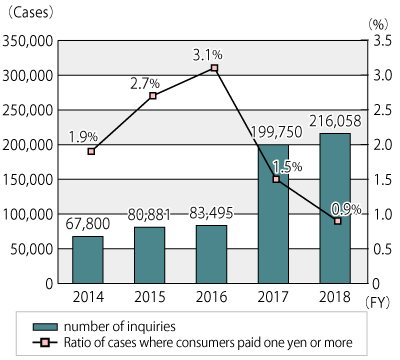Inquiries about billing fraud exceeded 200,000! If you don't remember anything about it, never contact the sender
Local consumer affairs centers and the like across Japan have received more than 200,000 inquiries about billing fraud. The annual number of the inquiries in FY2016 was about 80,000 and there was a sudden increase in FY2017. In FY2018 (as of March 2019), the number amounted to more than 200,000. In July 2018, "Package of countermeasures against billing fraud" was formulated by the Consumer Policy Council. The paper encouraged and facilitated efforts by related ministries, agencies and associations. The percentage of cases of financial damage incurred by billing fraud has been on the decrease.
On the other hand, there have been still numerous inquiries and complaints about billing fraud. Therefore, NCAC decided to inform updated information about billing fraud and advise to help protect consumers from detriment.
Diagram: Transition in the annual number of inquiries registered to PIO-NET*

The number of inquiries was 67,800 in FY2014, 80,881 in FY2015, 83,495 in FY2016, 199,750 in FY2017, and 216,058 in FY2018. The ratio of cases where consumers paid one yen or more was 1.9% in FY2014, 2.7% in FY2015, 3.1% in FY2016, 1.5% in FY2017, and 0.9% in FY2018.
- *PIO-NET is a database that collects information on inquiries concerning consumer affairs by linking NCAC with local consumer affairs centers and similar organizations across Japan via an online network. The above graph shows data registered through March 31, 2019, not including inquiries referred to NCAC from local consumer affairs centers. The number of inquiries in the comparable period of FY2017 was 182,927 (data registered to PIO-NET through March 31, 2018).
Recent tactics highlighted by sampling of inquiries and complaints
- Various communication channels are used by billing fraudsters.
- Fraudsters stir up anxiety of consumers in many ways to make consumers contact them.
- If you contact the sender, they charge you money.
- Several means of payment are misused.
Sample cases
Cases where a sender uses an official-sounding name
Some consumers received a postcard titled "Final notice of lawsuit over total consumption charges" from a sender claiming to be with a public institution, and paid money using a certain payment code specified by the sender.
Cases where a sender uses an existing company's name
Some consumers were billed for adult website service via telephone by someone claiming to be with a major mail-order company, and made a payment with prepaid card.
Cases where a sender indicates personal data of the addressee
Some consumers received an email titled "Special Disclosure Notice", which includes the addressee's name.
Advice for consumers
- If you don't remember anything about what you are billed for, never contact the sender.
- If you can't judge whether it's billing fraud or not and feel uneasy, or if you have been billed persistently, consult your local consumer affairs center or police.
